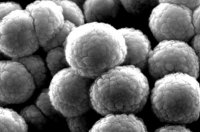
Better drug delivery
Nanomaterials have brought benefits to medicine. A drug embedded in a controlled-release substance (made of nanomaterial) can be released slowly and smoothly over several hours, so that the level of the drug in the body stays constant.
In the past, drugs had to be given in one sudden “hit”, so doses had to be higher, and the level of the drug would fluctuate throughout the day.
The picture shows one of the nanomaterials we’re studying here at the Centre for Antimatter-Matter Studies (CAMS).
These hollow shells are made of silica.
Each one measures just a millionth of a millimetre across.
 We’re investigating to see if this nanomaterial would make a good controlled-release device for drug delivery.
We’re investigating to see if this nanomaterial would make a good controlled-release device for drug delivery.
Cutting down on chemicals in agriculture
In just the same way, a controlled-release substance can release fertiliser slowly and smoothly into the soil.There’s less fluctuation in the quantity of fertiliser present in the soil, less waste, and less residue.
Keeping food fresh
No-one likes wasting food, whether it’s at the farm, at the warehouse, or in your refrigerator.
At every stage of food production, we keep food fresh by wrapping it, and modern plastics can keep food fresh for longer than traditional packaging.
The everyday plastic wrap you use when you pack your lunch has been very carefully designed not to be completely airtight. Instead, it’s able to breathe just the right amount, because it contains tiny pores which have been measured using antimatter.









